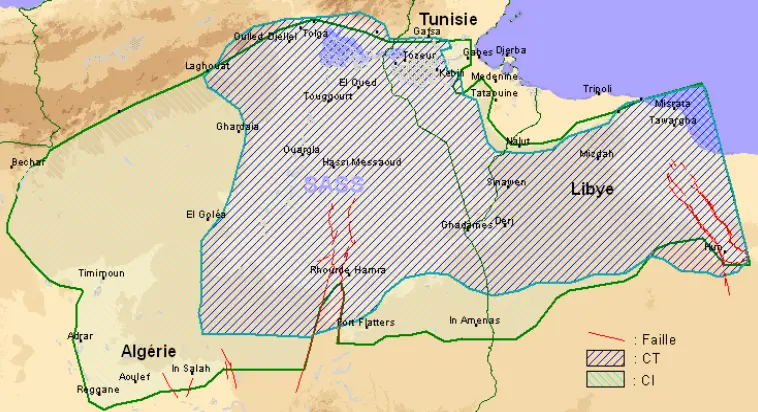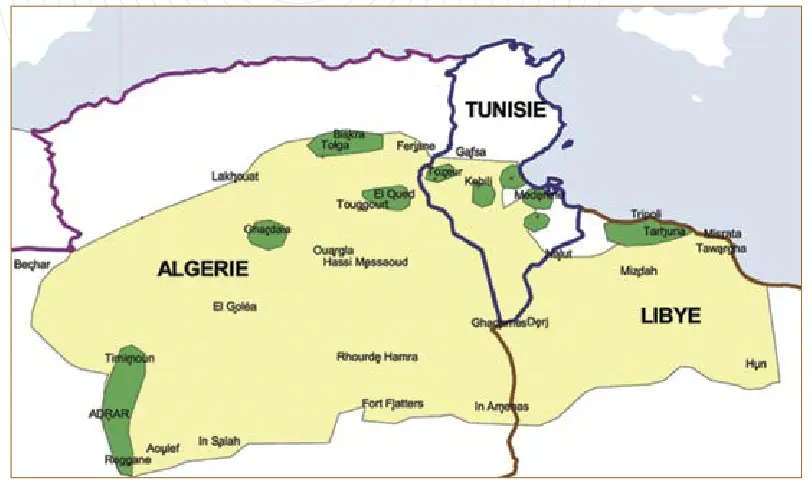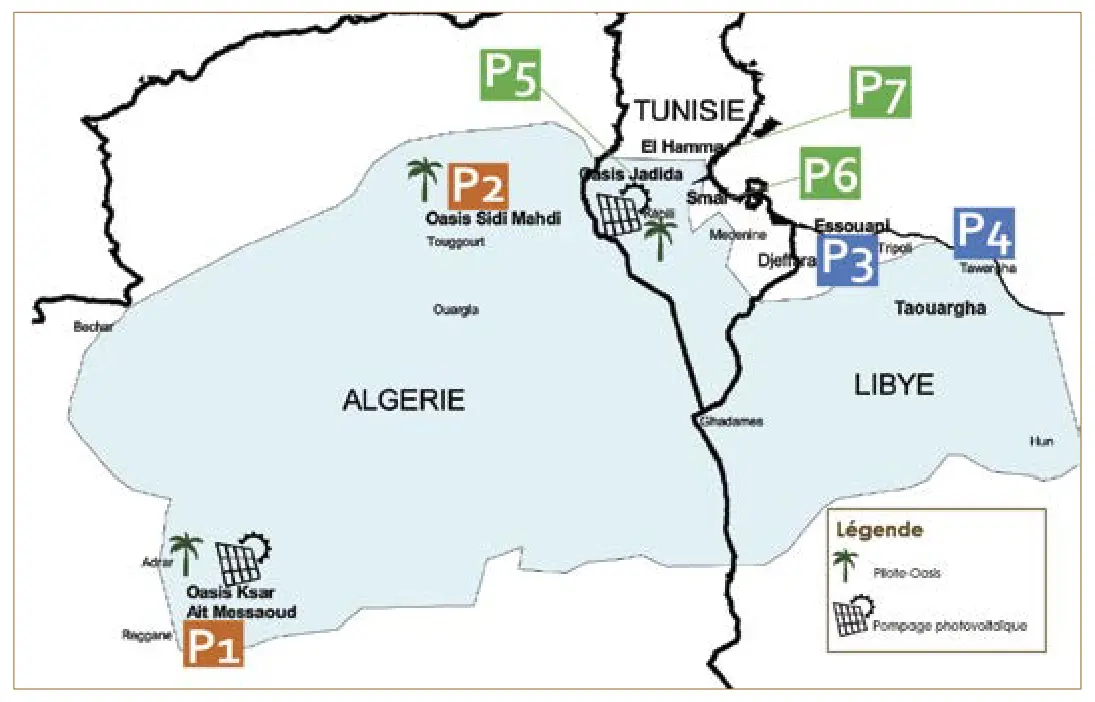SASS
Sistema Aquífero do Sara do Norte (Argélia, Líbia, Tunísia)
SASS
Voltar
Download the practice
People in charge of the innovative practice :
Não conhecido
The Northern Sahara Aquifer System (SASS) shared by Algeria, Libya and Tunisia, is a basin that covers an area of nearly 1 million km² and whose water resources are not very renewable. With the objective of establishing sustainable development in the region, the Sahara and Sahel Observatory (OSS) has conducted between 1999 and 2015, studies through three projects (SASS I, SASS II, and SASS III). The SASS project, which started in 1999, has thus reached the third phase of its implementation. After having deepened the knowledge of the resource during the previous phases (hydrological and hydrogeological aspects), the third phase focused on water uses (mainly agricultural) and, more generally, on the socio-economic and environmental aspects related to irrigation practices in the basin.

Figure 1 : Northern Sahara Aquifer System (SASS).
These studies allowed a better hydraulic knowledge of the system, the setting up of a common information system and the establishment of a permanent consultation mechanism between the three countries. In addition, these studies have highlighted the fact that the agricultural development in its current form (based on supply), is a source of risks related to the costs of mobilizing water and its salinization as well as the degradation of soil quality. They have also shed light on the lack of efficiency of irrigation and the low value of water. This situation is likely to worsen in the future given the growth in needs and the impacts of climate change. Finally, these projects have produced operational recommendations for sustainable agriculture with the preservation of water and soil resources.
Responsible entity
The Sahara and Sahel Observatory (OSS) is an international organization that operates in the arid, semi-arid, sub-humid and dry areas of the Sahara-Sahel region. Created in 1992, the OSS has been based in Tunis, Tunisia, since 2000. OSS has 26 African countries and 13 organizations among its members. OSS initiates and facilitates partnerships around common challenges related to shared water resources management, implementation of international agreements on desertification, biodiversity and climate change in the Sahara-Sahel region.
The main actions carried out by the OSS are
- The implementation of multilateral agreements on desertification, biodiversity and climate change;
- The promotion of regional and international initiatives related to environmental challenges in Africa;
- The definition of concepts and harmonization of approaches and methodologies related to sustainable land and water resources management and climate change.
OSS necessarily relies on knowledge transfer, capacity building and awareness raising of all stakeholders.
OSS activities and projects are financed respectively by voluntary contributions from member countries, and by grants and donations from development partners. With effective governance mechanisms and a competent, multicultural and multidisciplinary team, OSS makes a high value-added contribution to the international and African institutional landscape.
Detailed explanation
Different developments were carried out within the framework of the SASS project according to the different phases:
SASS I
Phase I consisted in an improvement of the hydraulic knowledge of the aquifer system. Concretely, this resulted in: (i) the creation of a common database with more than 9,000 water points; (ii) the development of a hydraulic management model to evaluate the impacts of withdrawals on the resource; and (iii) the establishment of a consultation structure at the technical level.
SASS II
The second phase of the SASS project aimed to achieve the following objectives: (i) the realization of two sub-models (Biskra and Western Basin in Algeria) and the model of the Tunisian-Libyan Djeffara; (ii) the establishment of a diagnosis on the agricultural practices; and (iii) the setting up of a Concertation Mechanism at the institutional level between the three countries whose coordination unit is hosted by the OSS.
SASS III

Figure 2 : Map showing the location of the survey areas.
Phase III consists of two components. The socio-economic component aimed at describing the functioning of the farms and the behavior of the main user, namely the irrigator. It enabled a quantitative and qualitative inventory of irrigated agriculture throughout the basin to be drawn up. After consultation between the OSS and the partners of the three countries, thirteen areas were initially selected for their representativeness of the agricultural, environmental and economic problems observed throughout the basin. In the end, ten areas were investigated. A sample of 3,000 farms was selected from the ten survey areas on the basis of several criteria to ensure its representativeness, including the proportion of irrigated areas, the size of the farms and the type of access to water. Two survey campaigns were conducted on this sample (4139 surveys out of 4500 planned). The survey questionnaire was developed on the basis of twelve themes covering both the quantitative and qualitative aspects of the irrigators’ activity. In order to provide decision-makers with an appropriate tool to help them design and implement agricultural development policies through the SASS, a hydro-economic model was developed. It is a tool that explicitly integrates economic calculation into the heart of water resources management by evaluating the goods and services generated by the different agricultural uses of this resource; it allows the simulation of scenarios on a quantified and adequately quantified basis. This hydro-economic model has been designed and made operational thanks to the global and micro-economic data collected and the results obtained from the quantitative analysis. Its application is possible on a regional or local basis within the basin. The model, whose objective is to maximize the income of the whole irrigated activity under appropriate economic and hydraulic constraints, allows to obtain for any scenario constructed: (i) the maximum volume to be pumped from the aquifer, and (ii) the maximum revenue generated. Depending on the results obtained, the decision-maker in the field will thus be able to base his policy on the scenario he prefers.

Figure 3 : Map of the location of the pilot agricultural demonstration sites.
For the agricultural demonstration pilots component, six demonstration pilots, representing four main problems of Saharan agriculture, were selected in close collaboration with the institutions in charge of water management in the three countries. The issues addressed are: (i) water scarcity; (ii) water salinization; (iii) irrigation inefficiency; and (iv) soil quality degradation.
Future outlook
The prospects are to continue to perpetuate the practice, and to manage to reverse the trend of depletion of water resources, but the process involving three different countries is long.
Institutional setting
The stakeholders of the project are OSS as the project owner. The first phase of the SASS project was carried out with the support of SDC Switzerland, IFAD, FAO, UNESCO and GIZ. The second phase was carried out with the support of SDC Switzerland, FFEM (France), Global Environment Facility (GEF), United Nations Environment Programme (UNEP), UNESCO and GIZ. The third and final phase was carried out with the support of the FGEF and the GEF.
Geographical setting
The SASS is a deep aquifer shared between Algeria, Tunisia and Libya. The SASS designates a complex superposition of aquifers with two main layers housed in two different geological formations: the Continental Intercalary (CI or Albian) and the Terminal Complex (TC). The SASS extends over one million km² and contains considerable water reserves, but they are not very renewable and cannot be fully exploited. The situation of overexploitation, confirmed by the model set up by the OSS SASS project, has exposed the SASS to increased risks of water salinization, disappearance of artesianism, and drying up of outlets. The SASS area covers regions ranging from desert areas (with annual rainfall <100 mm and evapotranspiration >3000 mm) to arid areas (with annual rainfall of 100-200 mm and evapotranspiration of the order of 2000-2500 mm).
Historical overview
1950s-1960s: Tunisia and Algeria noted a drop in pressure in their hydraulic works.
Years 1970-1980: ERES project, for the study of the water resources of the Northern Sahara.
From 1999 to 2002, a first study was carried out, within the natural limits of the basin, which was until then apprehended on a national scale or in the framework of bilateral collaborations. In 2003, new studies to consolidate knowledge on hydraulic aspects and agricultural diagnoses were launched. They shed light on the lack of efficiency of irrigation, the poor use of water and the degradation of soil quality. This observation highlighted the fragility and unsustainability of the cropping systems prevailing in the SASS basin. In 2006 and following a process led by OSS during the previous study phases, the three countries set up a common management framework, the Concertation Mechanism, with the mission of carrying out a concerted policy for sustainable groundwater management at the basin level. The overexploitation of the System, with the environmental and socio-economic risks that this implies, led the countries to agree on objectives to control water demand, improve its productivity and protect the environment. Efforts have focused on the agricultural sector, which is the largest user of groundwater in the basin. In 2009, OSS initiated the third phase of the project. This third phase of the SASS project developed recommendations for the implementation of a basin-wide sustainable land and groundwater resources management strategy.
Evidence of benefits from implementation
The SASS project has resulted in significant water savings of up to 45% and a tenfold increase in farmers’ income.
Socio-economic component
The considerable number of farms surveyed has opened the field of knowledge of the behavior of agricultural water uses and users in the three SASS countries. The analysis of the data has made it possible to quantify the impact of salinization on water productivity and the effect of the price of water on its consumption. The considerable contribution of the socio-economic component was, on the one hand, to allow a readability of the viability of the exploitation when the quality of the water is degraded and to give simple economic indicators which must alert the decision makers. On the other hand, the study highlighted the importance of structural factors for the viability of farms. In particular, it emphasized the importance of the social organization of the farm (involvement of the family workforce, level of education of the farmers, experience in irrigation, farmer/breeder combination) as a determining factor in water productivity. The socio-economics component showed that it was possible to value water in a sustainable way, provided that the determining factors of the farmer’s behavior were taken into account: who consumes water, in what order and how. In this approach, it was also shown that in the SASS, the main users of water were the farmers with individual access by private drilling. This category of farmers is also the one that produces the most wealth per m3 of water. The relatively high water productivity of the “private” group is thought to be due to the fact that paying for water makes the farmer more efficient.
Demonstration pilots
This component had a primarily agri-environmental focus, however, it is important to note that an innovative social approach achieved through multi-stakeholder consultation and participation contributed to the achievement of the objectives. Farmers, as the main decision-makers, were strongly involved in the realization of the work in an exemplary synergy with the partner research institutions. The pilots demonstrated that it is possible to convince farmers to adopt sustainable water and soil management practices, including more efficient irrigation. They have also demonstrated to farmers, in a concrete way, that it is possible to make better use of water while preserving the ecosystem.
The pragmatic and pedagogical way of convincing farmers made them willing to pay for irrigation water and to invest in better efficiency. It was the perception of the value of water that changed for the farmers. The pilots promoted dialogue between farmers and acted as a vehicle for agricultural extension and the dissemination of innovations. On the other hand, they have facilitated the social acceptability of innovations. These dynamics are promising and can help revitalize interest in irrigated agriculture in certain regions throughout the basin. The “agricultural demonstration pilots” component has paved the way for improved living conditions for farmers, stabilization of populations and better conservation of the resource.
Replication potential in SUDOE region
The main success factors of the project were to reach a consensus between the three countries to face this problem. On the other hand, the support of a structure such as the OSS, which listens to the countries and their needs, makes it possible to encourage better management of the transboundary resource. We also note in this project a strong involvement of the civil society. Even if the project has been able to benefit from subsidies (each year, each country contributes 30k€), one of the problems raised is the lack of financial means for the field part. Human resources are dedicated to the daily management of this practice, including units of coordinations to organize training workshops, water workshops. This type of project also has a strong potential for replication for trans-regional water resource management issues.
Key points of the innovative method
> Mechanism of dialogue between countries
> Pedagogy of proximity with the farmers
> Social acceptability
> Socio-economic approach
Acknowledgements
The innovative practice was suggested by Yvan KEDAJ (Aqua-Valley) and Abdel Kader DODO, Lamine BABA SY, and Nabil BEN KHATRA (OSS) participated in the interview.
References
OSS (2003). Système Aquifère du Sahara Septentrional : Hydrogéologie, volume II. ISBN : 9973-856-00-7
OSS (2003). Système Aquifère du Sahara Septentrional : Modèle mathématique, volume IIII. ISBN : 9973-856-02-3
OSS (2008). Système Aquifère du Sahara Septentrional : gestion commune d’un bassin transfrontalier. ISBN : 978-9973-856-31-9
OSS (2015). Pour une meilleure valorisation de l’eau d’irrigation dans le bassin du SASS. Diagnostic et recommandations. https://www.riob.org/fr/file/287377/download?token=xJ5UvckF – consulté en ligne le 17 janvier 2022.
aquifer
NOTÍCIAS
Descubra mais sobre as notícias do projeto AQUIFER e sobre a gestão de aquíferos
NOTÍCIAS AQUIFER
Descrição e objectivos do projecto
The scientific community recommends a substantial improvement in the knowledge of aquifers, the establishment of reliable monitoring networks and a greater involvement of the administration and users to achieve a sustainable management of aquifers. The main objective...
Informação sobre o projecto
A Comunidade de Utilizadores de Água do Delta Llobregat concebeu bacias de recarga em Molins de Rei para recarregar o aquífero do Baix Llobregat. Vista de uma das bacias de recarga durante a fase de teste A Comunidade de Utilizadores de Água de Llobregat Delta é um...
Histórias de sucesso na gestão das águas subterrâneas
Compilação de histórias de sucesso na gestão das águas subterrâneas. Ao longo do mês de Abril, os 30 casos de práticas inovadoras na gestão das águas subterrâneas já foram seleccionados pelos agrupamentos que participam no projecto: PPA, CWP e AV. A tarefa começou com...
PROPONHA UMA
PRÁTICA INOVADORA
Está a desenvolver ou implementar uma prática inovadora em matéria de gestão de aquíferos e deseja referência-la na plataforma do projeto AQUIFER?
Preencha o formulário e faça uma proposta aos parceiros do projeto AQUIFER.
THE E-BOOK
O Aquífero oferece uma gama de práticas inovadoras de gestão da água. Pode descarregar todas as nossas fichas técnicas aqui.
E-BOOK DE PRÁTICAS INOVADORAS
DOCUMENTAÇÃO
Aprofunde a informação relacionada com a gestão dos aquíferos